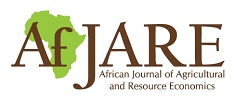Are the current animal trypanosomiasis management methods in Kenya complementary or substitutes? Evidence from Kwale County
Arnold Lumumbah Musungu, David Jakinda Otieno, Beatrice Wambui Muriithi, Rose Nyikal, Daniel Masiga & Michael Nyanganga Okal
Abstract
African animal trypanosomiasis (AAT) and its vectors, mainly tsetse, are a major constraint to livestock production in sub-Saharan Africa (SSA). Control efforts have been ongoing for decades, but finding a sustainable solution remains a major concern. This paper assessed the complementarity and substitutability of existing AAT management methods to inform policies toward an integrated approach. A multivariate probit (MVP) analytical technique was used to model interrelationships in the control methods from 308 randomly selected livestock keepers. The results show that the current AAT control methods are complementary and not substitutes. Furthermore, the number of years of formal education, household size, household income and land size had mixed effects on the households’ decisions to adopt multiple AAT control methods. The key institutional factors that influenced the adoption behaviour were access to credit, group membership, access to veterinary services and drugs, and agricultural training. The results instil confidence in integrated AAT management if livestock farmers’ socio-economic and institutional constraints are addressed sufficiently.
